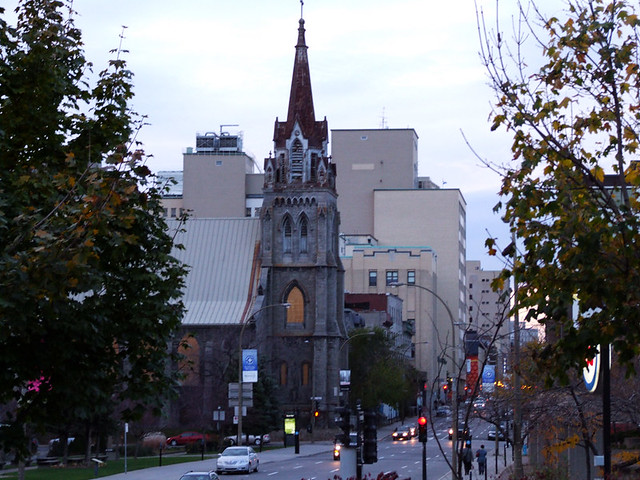“Sauvons l’église Saint-Sauveur!” I wrote three years ago. And for three years, it seemed vaguely possible that the 145-year-old church on lower Saint-Denis Street wouldn’t be demolished. The huge hospital for which it was supposed to make way, the Centre hospitalier de l’Université de Montreal (CHUM), has been stalled for years, and for awhile it would have been reasonable to guess that it would eventually crawl into the back room where tired, abandoned Montreal megaprojects go to die.
Alas, that wasn’t the case. Kristian Gravenor broke the news in yesterday’s Gazette that city council has issued a demolition permit for the church, which has sat empty and abandoned for years. It isn’t in the best shape — its prized stained glass windows, designed by the renowned Guido Nincheri, were stolen in 2006 — but its bones are strong. More importantly, it remains a testament to the city’s history.
Saint-Sauveur was built thirteen years after a fire swept through the Faubourg Saint-Laurent in 1852, its greystone façade, neo-Gothic architecture and tin steeple a testament to the fashion of the era. In the beginning, it was actually an Anglican church named Holy Trinity. It didn’t become Catholic until the 1920s, when Holy Trinity moved west to NDG and the church was sold to a Syrian congregation.
According to Gravenor, the only trace of the church that will remain after its demolition will be “a representation of its original steeple,” which burned down in the 1920s. Four adjacent greystone houses will be destroyed along with the church. And for what? A bloated super-hospital that will concentrate services that should really be spread around the city.
“The new hospital building will probably have a space about the size of the church where they’ll want people to congregate,” said Dinu Bumbaru, the policy director of Heritage Montreal. “It will have drywall and dropped ceilings and art in the corner rather than use this great Gothic cathedral — that’s how they will dehumanize this space.”
The sad thing is, it didn’t have to be this way. Though the collapse of religious observance has left Montreal with many empty churches, it has been generally good at keeping its oldest temples of faith alive, even if it means converting them into condos. UQAM’s 1960s-era campus, located just up the road from Saint-Sauveur, incorporated the magnificent steeple and woodwork of the Église Saint-Jacques, built in 1857.
Last July, more than two years after I first wrote about the church, somebody named Tony posted a comment: “My partner and I made a bid for this church in 1999. We came close to a deal, but it fell apart. We were going to transform it into a place for small, intimate concerts, the acoustics were top notch and the stained glass windows were phenomenal. It would have been quite the venue.”
If only.



2 comments
breaks the heart.
I just don’t understand (well I do, but don’t want to) why this is happening. For a city that is suppose to be full of culture, and diverse style we sure are destroying it at an alarming rate.
Its seems to be trend in Montreal, the building become heritage, building stays in use, after time its use expires or the building falls in a state that requires a lot of repairs (a lot of money), close the building let it fall in on its self to the point that is more feasible to destroy and rebuild something new instead of repair it.
Hence allowing city to sweep in and build some monster of a building (in this case a hospital – which I completely agree with the comment above – de-humanize the area).
All because it A) its a heritage building and people (owners/promoters) don’t want to pay (or can’t afford in a few cases) to respect the heritage laws or B) its a church and is currently in a grey area of planning in terms of re-use (re-zoning).
Yesterday we installed the new steeple on the replica of Saint-Sauveur church. Most of the stone were save to rebuilt the top part and the steeple was rebuilt using old photographs of the old steeple that burned down. I know it’s not the original church but I think that everyone who worked on the construction of the replica did their best to keep the essence of it. I really enjoyed working on the project ( i was the draftman for the structural steel of the steeple) and proud to have been part of it. You should follow up on this story.